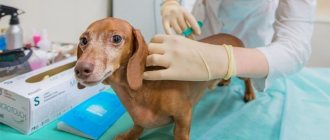Many people don’t even think that toxicosis occurs not only in pregnant bitches. The term means a pathological condition caused by poisoning of the body, and there are many causes of poisoning.
Toxicosis is not a disease and comes in several types. Toxins can come from the outside, for example, with food, inhaled vapors, smoke, or form as a result of impaired functioning of the kidneys or liver. As for toxicosis in pregnant dogs, the cause of its occurrence is considered to be hormonal changes that occur in the body of the bitch during pregnancy. Although some are inclined to believe that the pathological condition is the result of the body’s reaction to a foreign protein, namely to the developing fetus. However, toxicosis sometimes occurs during false pregnancy, and fetal rejection does not occur. Therefore, this version is not popular.
How to distinguish a false pregnancy from a real one
You can suspect that your favorite animal is carrying puppies based on the following signs:
- there is slight mucous discharge 30-35 days after the expected conception;
- during the same period (after 30 days), the pet’s weight begins to increase;
- nausea and vomiting;
- abdominal enlargement 40-45 days after the expected conception;
- loss of interest in food at the initial stage of pregnancy and its increase in the later stages;
- decreased activity.
False pregnancy occurs with symptoms such as enlarged mammary glands, increased interest in food, and anxiety. This is not a dangerous condition, but can cause complications, including mastitis and pyometra (purulent inflammation of the uterus).
The cause of false pregnancy is hormonal changes. Treatment in this case is symptomatic and etiotropic.
First of all, hormonal medications are prescribed that help suppress the activity of progesterone and prolactin, thereby reducing the severity of symptoms.
Which breeds are prone to toxicosis?
It is impossible for future owners of a pet that will participate in breeding to predict whether it will suffer from toxicosis or other negative symptoms that arise when bearing offspring. But in any case, the owner should prepare for the fact that the pet will need better care during this difficult period.
According to veterinary practice, toxicosis is more common in purebred females. This mainly applies to representatives of decorative, pocket breeds. However, larger dogs are also at risk:
- boxers;
- English bulldogs;
- Dogues de Bordeaux;
- mastiffs.
It is worth noting that toxicosis can occur without pregnancy, and also accompany false pregnancy.
Poor health in dogs
Many dog owners are interested in the question of whether toxicosis occurs in dogs during pregnancy. Yes, sometimes . But this is not considered a disease, but only a specific condition that goes away on its own after delivery.
The reason for this is the animal’s body’s reaction to the presence of toxic substances.
During pregnancy, dogs can develop the following types of toxicosis:
- exogenous, when toxic substances entered the body from the outside world through food, water, smoke, chemical vapors;
- endogenous, in this case, toxic components are produced by the body due to the defective functioning of the liver and kidneys.
According to researchers, toxicosis in a dog during the period of bearing puppies develops as a result of a specific reaction of the body to a foreign protein.
However, this version is refuted by breeders and dog handlers, who are of the opinion that this is a kind of cleansing of the body caused by changes in the hormonal system.
In case of toxicosis, it is necessary to carefully monitor your pets. Any deterioration should prompt a visit to the veterinarian, otherwise dangerous consequences may arise.
When does it start and how long does it last?
In mild form, toxicosis occurs at 3-4 weeks. The duration of this condition in an animal is 2-3 weeks.
If there is a suspicion of the pathological nature of the symptoms that arise that are not related to toxicosis, you can take tests: a general examination of urine and blood, blood biochemistry. If the indicators are normal, we can talk about toxicosis, which will go away on its own after childbirth .
In case of loss of appetite, severe thirst, general malaise, or persistent vomiting containing bile, it is recommended to immediately visit a veterinarian.
Such symptoms are especially dangerous in the second half of pregnancy.
A dog cannot cope with dehydration on its own. In any case, you will need the help of a specialist. If you neglect the symptoms, you can cause complications, including intrauterine death of future puppies.
Medical and surgical termination of unwanted pregnancy
The information below is provided for informational purposes only. You should make any decisions only after consulting a veterinarian.
Interruption is far from a harmless procedure. It's safer to prevent pregnancy from happening. To prevent unwanted pregnancy after unplanned mating, a drug with the active ingredient estradiol benzoate is used. It is administered on days 3 and 5 from random mating. If the time of mating is unknown, then the drug is also administered on the 7th day.
If time is lost and pregnancy is confirmed, it can be terminated medically or surgically. This is an extreme measure, but sometimes it is necessary. There are situations where childbirth is highly likely to result in injury or death to the dog. For example, if pregnancy occurred during the first heat, the female has an abnormal pelvic structure, the mating happened to a very large male, etc.
For medical interruption, a special hormonal drug is used (active ingredient: aglepristone). The hormone disrupts the normal physiological process of maintaining pregnancy in bitches, which leads to abortion or fetal resorption. Valid for up to 45 days after mating. Termination of pregnancy occurs within a week after administration. Contraindications: individual intolerance; it is also prohibited to use in dogs with impaired liver, kidney and adrenal function, as well as in patients with diabetes. After taking the drug, the dog retains reproductive functions, and estrus occurs at the usual time. The downside is that when used after the 20th day, abortion may occur with physiological signs of labor - this can cause false pregnancy in the future.
The surgical method of terminating an unwanted pregnancy consists of an operation to remove the uterus and fetuses. After such an intervention, the dog cannot have puppies. A contraindication may be a weak heart or other conditions in which the dog is prohibited from anesthesia.
Types of toxicosis
There are several types of toxicosis. The safest form for the bitch and fetus is the mild form that primiparous dogs are susceptible to. It lasts after mating for up to 3 weeks, gradually weakens and passes by the end of the third week.
Clinical manifestations of mild toxicosis are as follows:
- decreased interest in food;
- vomiting in the morning, in which there is white foam.
The acute form of toxicosis occurs more often in the late stage of pregnancy and has the following severe symptoms:
- frequent vomiting with bile;
- decreased animal activity;
- general malaise;
- lack of appetite.
Among the negative consequences of the acute form of toxicosis are intrauterine death of puppies, premature birth, and severe intoxication.
There is another form - prenatal, which veterinarians consider the most dangerous. Occurs in the last week of pregnancy.
Complications of late toxicosis affect not only the puppies in the womb, but also the bitch herself, who may die or fall into a coma. The symptoms are the same as those of the acute type, but with greater severity.
Gastrointestinal disorders
Your pet's sudden weight loss may be a symptom of numerous gastrointestinal (GIT) diseases that affect the functioning of the intestines and stomach. In addition, there may be other symptoms that you should pay attention to, namely:
- constipation or chronic diarrhea;
- regular vomiting;
- dehydration;
- generally sluggish state.
With diseases of the gastrointestinal tract, the animal loses its appetite, which naturally leads to weight loss, since the process of digesting food causes discomfort in it.
How to remove this condition
If toxicosis is mild, specific therapy is not carried out. The condition normalizes on its own.
If you have special taste preferences, it is not recommended to limit bitch in products.
The food included in the diet must correspond to the norm, taking into account the weight of the animal. If clinical manifestations of severe toxicosis (acute or prenatal) are present, it is worth visiting a doctor for consultation .
In most cases, severe forms of the condition are treated with intravenous infusions of solutions that improve the condition of the dog and puppies in the womb.
Urgent treatment of toxicosis is necessary if severe symptoms occur a few days before delivery. Surgery is performed to reduce the risk of coma and death.
What to do if your dog refuses food
Loss of interest in food during pregnancy is one of the symptoms accompanying pregnancy. You shouldn’t force feed an animal, but you shouldn’t ignore it either.
What to do if the dog doesn't eat? Veterinarians recommend looking for a product that you like. Animals, like people, can have strange taste preferences.
You can give an injection of Catozal, a drug that normalizes metabolic processes in the dog’s body.
There are special medications aimed at increasing appetite, for example, Enervit paste.
How to alleviate and prevent toxicosis
If a dog is suffering from vomiting due to toxicosis, you should provide it with access to drinking water, calm the animal and give an injection of glucose. Glucose will prevent dehydration of the body when refusing food and water, and will restore strength to the pet. You should not wait for the animal to return to normal on its own. You should go to the veterinarian, or call a specialist at home if it is not possible to take the dog to the hospital.
At the Kaliningrad Regional Clinical Center, your pet will be provided with qualified care - we provide veterinary services both in the veterinary clinic and at home. The doctor will conduct a visual examination, prescribe tests and diagnostic studies. For toxicosis, the following treatment and preventive measures are most often used:
- restoring water balance in the body with the help of medications that are administered to the animal through droppers;
- the use of vitamin preparations when signs of micronutrient deficiency are detected;
- if allergies occur, the doctor prescribes antihistamines that do not cause side effects in the animal;
- hormonal drugs if appropriate indications exist.
The veterinarians at our clinic in Kaliningrad and Svetlogorsk have all the necessary tools to diagnose and treat a wide range of diseases. The pharmacy stocks medications for animals. After visiting a specialist, you won’t have to look for where to buy the necessary medications. If necessary, we hospitalize dogs, and the veterinarian also gives recommendations on caring for the animal during pregnancy and the postpartum period. You can make an appointment or call a doctor at home by calling our clinic.
First signs of labor
The release of colostrum from the nipples should already serve as a signal for the beginning of the owner’s moral preparation to accept the birth of a dog. The bitch also shows changes in behavior - she becomes more restless, looks for a secluded place, scratches the floor, etc.
A day or several hours before the onset of labor, the dog may completely lose its appetite, its breathing becomes heavier and more intermittent, it appears as if groaning, it constantly walks from side to side, showing restlessness. But even at such a moment, much depends on the individual characteristics of the breed or a particular dog. For example, the owners of many cockers note that their pets happily eat literally a few hours before giving birth.
A harbinger of the onset of labor is a slight trembling caused by cramping attacks and the loss of amniotic fluid. At this point, you should be fully prepared to assist your dog and not leave his side at all times. And the doctor will help make the birth as safe as possible for both the mother and the newborn puppies.
Diabetes
Unfortunately, this disease is very common among members of the canine family. If the disease is not controlled, the animal may lose weight very quickly. Diabetes is often diagnosed precisely during examination in veterinary clinics, where people turn to for this symptom. In the vast majority of cases, diabetes progresses in older or middle-aged animals, when weight loss itself is a natural phenomenon due to the aging process. If your pet has already reached an impressive age, it is important to be especially careful to ensure that its weight remains stable.
Pregnancy
Dogs can easily become pregnant during their fertile period, also called estrus, which occurs on average every eight months and lasts up to three weeks. At this time, your pet can often enter into active clashes with the male dog pestering her. This happens if the dog feels that it is not yet ready for mating. That is why during the period of heat, in order to avoid such clashes, as well as mating with unfamiliar males, it is recommended to walk the dog on a leash, keeping it under control at all times.
Symptoms of toxicosis in puppy bitches
The pathological condition, which manifests itself in a mild form, does not harm either the mother or the developing fetuses, it only causes discomfort to the animal. Symptoms of mild toxicosis are malaise, poor appetite, picky eating, mood swings (aggressiveness and nervousness), and possible vomiting of white foam. In this condition, the animal should be under constant supervision, and if the condition worsens at the slightest, you should contact a veterinary clinic.
In acute toxicosis, loss of appetite, severe thirst, depressed state, and vomiting with bile are observed. If symptoms are observed in the second half of pregnancy, you should immediately seek help from a veterinarian due to the risk of fetal rejection.
Prenatal, a pathological condition that appears a few days before birth, is considered the most dangerous, since the animal can fall into a coma, which can lead to the death of the puppies and the bitch herself.
Care and nutrition after childbirth
Even if the dog felt good before giving birth, this many-hour process is very tiring and exhausting for her. She is weakened and now feels additional concern for her offspring. However, you should try after a while, even if forcefully, to take her out for a very short walk. After a walk, pay special attention to cleanliness - wash your paws and belly thoroughly with soap, wipe dry with a towel, and after that you can place the dog with the puppies, which you have already moved to the prepared place for their stay.
Do not forget that a dog after giving birth requires abundant and frequent nutrition. However, the first meal should take place approximately 7-8 hours after the last puppy emerges. We recommend offering it with rice milk porridge, well boiled, with sugar and butter. In the future, be sure to saturate the diet, in addition to regular food, with sweetened tea with milk.
What to feed your dog
The first rule is that the dog is not given food for the first 12 hours after vomiting . Therapeutic fasting will allow the dog’s stomach to rest and recover, and the body to cleanse itself. At the same time, you need to offer your dog fresh water (preferably filtered) - 2 teaspoons per 1 kg of weight. In order to restore the salt balance in the body and prevent dehydration, Regidron is prescribed in the dosage indicated on the package.
Subsequently, a special diet is prescribed for therapeutic purposes and for prevention.
Dry food
For therapeutic and restorative purposes, dogs are prescribed special dietary foods:
- Hill's Prescription Diet I/D Canine Gastrointestinal Health dry
- Flatazor Protect Obesite;
- Advance Veterinary Diets Gastroenteric Low Fat Canine Formula;
- Pro Plan Veterinary Diets Canine EN Gastrointestinal dry;
- Happy Dog VET Diet Renal;
- Farmina Vet Life Canine Gastrointestinal;
- Royal Canin Gastro Intestinal Low Fat.
They switch to regular food gradually adding it to the dietary food. At the first feeding the proportion should be 1:1. Then, if vomiting does not recur, you can mix 3/4 regular food and 1/4 dietary food. If the dog tolerates the food well, after 3 days you can return to the normal diet.
Natural food
Naturally fed dogs are switched to light food. After “therapeutic hunger,” the dog is offered 2-3 teaspoons of low-fat, easily digestible food.
It could be:
- skim cheese;
- curdled milk;
- boiled rice;
- steamed beef meatball;
- boiled potatoes;
- oatmeal;
- boiled chicken breast without skin.
You need to feed little by little, but often, offering the dog food every 1-2 hours. For feeding, carbohydrates and proteins are mixed in equal proportions. All food should be without salt and seasonings. The transition to a normal diet is allowed only after 3-4 days.
Important!
If the diet does not help, or your dog continues to vomit, contact your veterinarian immediately.











